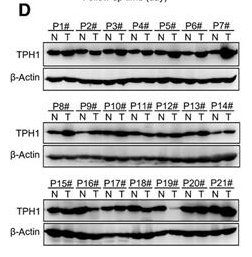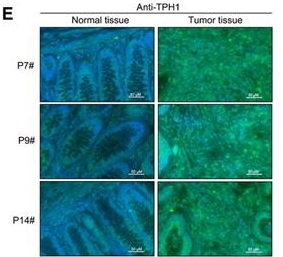Tryptophan Hydroxylase Antibody - #DF6465
製品説明
*The optimal dilutions should be determined by the end user. For optimal experimental results, antibody reuse is not recommended.
*Tips:
WB: For western blot detection of denatured protein samples. IHC: For immunohistochemical detection of paraffin sections (IHC-p) or frozen sections (IHC-f) of tissue samples. IF/ICC: For immunofluorescence detection of cell samples. ELISA(peptide): For ELISA detection of antigenic peptide.
引用形式: Affinity Biosciences Cat# DF6465, RRID:AB_2838427.
折りたたみ/展開
Indoleacetic acid 5 hydroxylase; L tryptophan hydroxylase; MGC119994; TPH 1; TPH; TPH1; TPH1_HUMAN; TPRH; TRPH; Tryptophan 5 hydroxylase 1; Tryptophan 5 monooxygenase 1; Tryptophan 5 monooxygenase; Tryptophan 5-hydroxylase 1; Tryptophan 5-monooxygenase 1; Tryptophan hydroxylase 1;
免疫原
A synthesized peptide derived from human Tryptophan Hydroxylase, corresponding to a region within the internal amino acids.
- P17752 TPH1_HUMAN:
- Protein BLAST With
- NCBI/
- ExPASy/
- Uniprot
MIEDNKENKDHSLERGRASLIFSLKNEVGGLIKALKIFQEKHVNLLHIESRKSKRRNSEFEIFVDCDINREQLNDIFHLLKSHTNVLSVNLPDNFTLKEDGMETVPWFPKKISDLDHCANRVLMYGSELDADHPGFKDNVYRKRRKYFADLAMNYKHGDPIPKVEFTEEEIKTWGTVFQELNKLYPTHACREYLKNLPLLSKYCGYREDNIPQLEDVSNFLKERTGFSIRPVAGYLSPRDFLSGLAFRVFHCTQYVRHSSDPFYTPEPDTCHELLGHVPLLAEPSFAQFSQEIGLASLGASEEAVQKLATCYFFTVEFGLCKQDGQLRVFGAGLLSSISELKHALSGHAKVKPFDPKITCKQECLITTFQDVYFVSESFEDAKEKMREFTKTIKRPFGVKYNPYTRSIQILKDTKSITSAMNELQHDLDVVSDALAKVSRKPSI
種類予測
Score>80(red) has high confidence and is suggested to be used for WB detection. *The prediction model is mainly based on the alignment of immunogen sequences, the results are for reference only, not as the basis of quality assurance.
High(score>80) Medium(80>score>50) Low(score<50) No confidence
研究背景
Isoform 2 seems to be less widely expressed than isoform 1.
Belongs to the biopterin-dependent aromatic amino acid hydroxylase family.
研究領域
· Metabolism > Amino acid metabolism > Tryptophan metabolism.
· Metabolism > Metabolism of cofactors and vitamins > Folate biosynthesis.
· Metabolism > Global and overview maps > Metabolic pathways.
· Organismal Systems > Nervous system > Serotonergic synapse.
参考文献
Application: WB Species: Human Sample: THP-1 cells
Application: IF/ICC Species: Human Sample: THP-1 cells
Application: WB Species: Human Sample: QGP-1 cells
Restrictive clause
Affinity Biosciences tests all products strictly. Citations are provided as a resource for additional applications that have not been validated by Affinity Biosciences. Please choose the appropriate format for each application and consult Materials and Methods sections for additional details about the use of any product in these publications.
For Research Use Only.
Not for use in diagnostic or therapeutic procedures. Not for resale. Not for distribution without written consent. Affinity Biosciences will not be held responsible for patent infringement or other violations that may occur with the use of our products. Affinity Biosciences, Affinity Biosciences Logo and all other trademarks are the property of Affinity Biosciences LTD.






